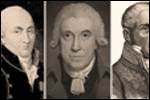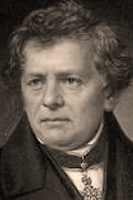 Free technical library
Free technical library
Georg Simon Ohm (1789-1854). Biography of a scientist

Directory / The life of remarkable physicists
 Comments on the article
Comments on the article

Georg Simon Ohm
The remarkable German physicist Georg Simon Ohm (1789-1854), whose name bears the famous law of electrical engineering and the unit of electrical resistance, was born on March 16, 1789 in Erlangen (Federal State of Bavaria). His father was a well-known master mechanic in the city. The boy Om helped his father in the workshop and learned a lot from him. He would have been a mechanic and continued his father's work, but Om was ambitious, he wanted to become a scientist and work in the best German universities. He went to study at the university in Erlangen and graduated in 1813. His first job was as a teacher of physics and mathematics at a real school in Bamberg.
After several years at the school, Ohm's dream came true. In 1817 he became professor of mathematics at the Jesuit College in Cologne. Here Ohm engaged in research in the field of electricity, using the Volta battery. Ohm made electrical circuits from conductors of various thicknesses, from various materials, of various lengths (moreover, he pulled the wire himself using his own technology), trying to understand the laws of these circuits. The complexity of his work can be understood by remembering that there were no measuring instruments yet and about the strength of the current in the circuit could be judged by various indirect effects. Omu really benefited from the skills he had acquired while working in the workshop with his father. And he also really needed perseverance, because the experiments went on for 9 years.
To characterize the conductors, Ohm in 1820 introduced the concept of "resistance", it seemed to him that the conductor resists the current. In English and French, resistance is called resistance, so a modern circuit element is called a resistor, and the first letter R from Ohm's light hand is still used as a designation for a resistor in circuits. In 1827, Ohm's fundamental work "Mathematical Study of Galvanic Circuits" was published, in which Ohm's famous law was formulated.
It would seem that such a simple mathematical formula, which is now being studied in schools, should deserve universal recognition, but it turned out the other way around. Colleagues took hostility Om's conclusions, ridicule began at him. Offended, Om quit his college in Cologne. In the following years, Ohm lived in poverty, working as a private teacher in Berlin. Only in 1833 did he manage to get a job at the Polytechnic School in Nuremberg.
In the meantime, the importance of Ohm's work was recognized abroad. In 1841 the British Royal Society awarded him a gold medal, and in 1842 elected Om as a full member. Finally, in 1849, Ohm became a professor at the University of Munich. Only 5 years he had the opportunity to fully work and teach. July 7, 1854 Georg Simon Om died.
In 1893, the International Electrotechnical Congress decided to introduce a unit of electrical resistance and named it after Georg Simon Ohm, thus emphasizing the importance of his discovery for electrical engineering.
<< Back (Wilhelm Weber and Karl Gauss)
Forward >> (Michael Faraday)
 We recommend interesting articles Section Biographies of great scientists:
We recommend interesting articles Section Biographies of great scientists:
▪ Linnaeus Carl. Biography
▪ Sechenov Ivan. Biography
▪ Nikola Tesla. Biography
 See other articles Section The life of remarkable physicists.
See other articles Section The life of remarkable physicists.
 Read and write useful comments on this article.
Read and write useful comments on this article.
<< Back
 Latest news of science and technology, new electronics:
Latest news of science and technology, new electronics:
Machine for thinning flowers in gardens
02.05.2024
In modern agriculture, technological progress is developing aimed at increasing the efficiency of plant care processes. The innovative Florix flower thinning machine was presented in Italy, designed to optimize the harvesting stage. This tool is equipped with mobile arms, allowing it to be easily adapted to the needs of the garden. The operator can adjust the speed of the thin wires by controlling them from the tractor cab using a joystick. This approach significantly increases the efficiency of the flower thinning process, providing the possibility of individual adjustment to the specific conditions of the garden, as well as the variety and type of fruit grown in it. After testing the Florix machine for two years on various types of fruit, the results were very encouraging. Farmers such as Filiberto Montanari, who has used a Florix machine for several years, have reported a significant reduction in the time and labor required to thin flowers.
... >>
Advanced Infrared Microscope
02.05.2024
Microscopes play an important role in scientific research, allowing scientists to delve into structures and processes invisible to the eye. However, various microscopy methods have their limitations, and among them was the limitation of resolution when using the infrared range. But the latest achievements of Japanese researchers from the University of Tokyo open up new prospects for studying the microworld. Scientists from the University of Tokyo have unveiled a new microscope that will revolutionize the capabilities of infrared microscopy. This advanced instrument allows you to see the internal structures of living bacteria with amazing clarity on the nanometer scale. Typically, mid-infrared microscopes are limited by low resolution, but the latest development from Japanese researchers overcomes these limitations. According to scientists, the developed microscope allows creating images with a resolution of up to 120 nanometers, which is 30 times higher than the resolution of traditional microscopes. ... >>
Air trap for insects
01.05.2024
Agriculture is one of the key sectors of the economy, and pest control is an integral part of this process. A team of scientists from the Indian Council of Agricultural Research-Central Potato Research Institute (ICAR-CPRI), Shimla, has come up with an innovative solution to this problem - a wind-powered insect air trap. This device addresses the shortcomings of traditional pest control methods by providing real-time insect population data. The trap is powered entirely by wind energy, making it an environmentally friendly solution that requires no power. Its unique design allows monitoring of both harmful and beneficial insects, providing a complete overview of the population in any agricultural area. “By assessing target pests at the right time, we can take necessary measures to control both pests and diseases,” says Kapil ... >>
 Random news from the Archive Random news from the Archive Self-contained cooling cloth
11.09.2016
A group of scientists from Stanford University has developed a new type of plastic. Thanks to the pores, it can cool the surfaces enclosed in it without additional devices.
How to create clothes in which a person will never get hot? The human body radiates heat in the form of infrared waves. Therefore, the cooling fabric must allow infrared radiation to pass through and not allow heat radiation from the outside to pass through. The materials that exist today, which are used in the textile industry to produce "cooling" sportswear, only begin to work when your body releases moisture.
Unlike such moisture-dependent materials, nanoporous polyethylene is exactly what it is supposed to be: heat waves in the visible spectrum do not pass through it, so sunlight does not heat the skin covered by it. And the heat that radiates from the human body passes through it unhindered. The secret lies in the special placement of nanopores in the material and their size (50 to 1000). In the first experiments, the temperature of the device simulating the heat of the human body under the nanomaterial layer was 2,7 - 2,0 degrees lower than under the cotton cloth layer.
|
 Other interesting news:
Other interesting news:
▪ Recycling old plastic into soap
▪ Supersonic missile X-60A
▪ Vertex 450 Solid State Drives
▪ The aging molecule found
▪ Unraveled the secrets of the cat's sense of smell
 News feed of science and technology, new electronics
News feed of science and technology, new electronics
 Interesting materials of the Free Technical Library:
Interesting materials of the Free Technical Library:
▪ site section Welding equipment. Article selection
▪ article The transformation of Saul into Paul. Popular expression
▪ article How does the automatic control valve for space heating work? Detailed answer
▪ article Rules of bandaging. Health care
▪ article LED voltage indicator. Encyclopedia of radio electronics and electrical engineering
▪ article The cards are reversed. Focus Secret
 Leave your comment on this article:
Leave your comment on this article:
 All languages of this page
All languages of this page
Home page | Library | Articles | Website map | Site Reviews

www.diagram.com.ua
2000-2024







 Arabic
Arabic Bengali
Bengali Chinese
Chinese English
English French
French German
German Hebrew
Hebrew Hindi
Hindi Italian
Italian Japanese
Japanese Korean
Korean Malay
Malay Polish
Polish Portuguese
Portuguese Spanish
Spanish Turkish
Turkish Ukrainian
Ukrainian Vietnamese
Vietnamese


 See other articles Section
See other articles Section 